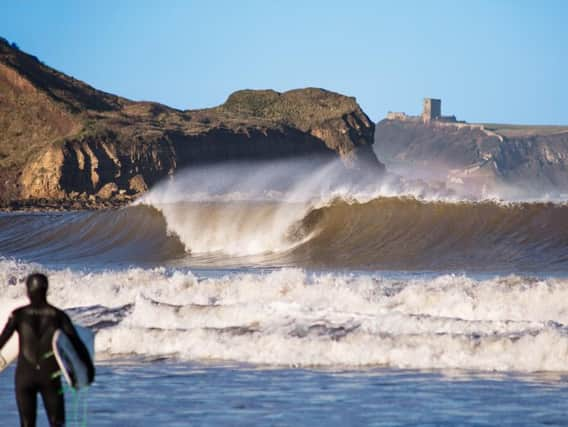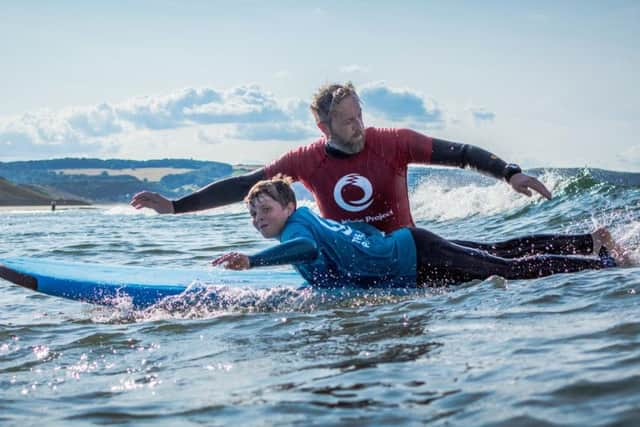Why Yorkshire coast is top spot for surfing


The chilly and rather murky waters off Yorkshire’s east coast may not be the first place that springs to mind when it comes to surf spots in the UK.
Yet it is the seaside resort of Bridlington that holds the earliest record of surfing in this country - and it was not a brave local that started the trend, but rather two Hawaiian princes no doubt more accustomed to the swelling waters of the Pacific than the bracing waves of the North Sea.
Advertisement
Hide AdAdvertisement
Hide AdToday, it is the South West coastlines of Devon and Cornwall that are perhaps best-associated with the sport. But thousands follow in the footsteps of those Hawaiian princes every year, hitting the waves on Yorkshire’s shores.


The shipwrecks you can still see along the Yorkshire coast“The surf market has really expanded and grown and people are realising that the east coast has world class waves,” says Paul Tomlinson, who runs Secret Spot surf shop and school in Scarborough. “It is cold and grey but it’s as good as anywhere in the world.”
Early days
Paul, who grew up and still lives in the town, began surfing in his late teens after meeting a tourist from New Zealand, who was travelling and surfing around the UK. “I didn’t know anyone else that surfed in the town. But one day a friend and I were driving around the bay at Scarborough and the conditions were perfect for surfing. We met about six people out there and got to know them all.”
The now 47-year-old recalls only a “handful” of people embracing Yorkshire’s surf at the time, with little more than ten regularly taking to the waves. They would watch the farming forecast to try to predict when conditions would be optimal - and then take their boards to North or Cayton Bay.
Advertisement
Hide AdAdvertisement
Hide AdThe idea for the shop grew from there. It was founded in 1989 by Roger Povey, a surfing friend of Paul’s, who had previously run a board hire scheme from a trailer at North and South bay. Paul joined him in the venture a year later.
How Scarborough community is working to transform the seaside town“It was started mainly because there was a need for us all to get surfing equipment,” he says. Thirty years on, as well as selling everything from wetsuits to travel essentials, clothing and surfboards, it now offers lessons through its surf school.
The cold North Sea
“Surfing has become more mainstream and there’s no longer a taboo about going out in the North Sea,” Paul reflects. “We have got world class waves on our doorstep and there’s no need to be put off by the cold.”
Though he describes the experience as “a little bit less glamorous than the south west because the water’s not as clear”, Paul claims when conditions are at their best, there are waves reaching more than 10ft and several hundred surfers out along Yorkshire’s coast enjoying them.
Advertisement
Hide AdAdvertisement
Hide AdHe puts the growth in popularity in part down to shops and surf schools making the sport more accessible, including with kit designed for cold water surfing. And he says the geography of Yorkshire’s coastline, with natural reefs, inlets and coves, makes it a prime spot. “Depending on the swell direction and the tides, there’s always places to surf. The east coast is as good as anywhere in the world on its day.”
Fit for royalty
It was certainly good enough for those Hawaiian royals - and way back in the late 1800s. A letter discovered deep in the archives of the Bishop Museum in Honolulu, and released to coincide with the opening of the Museum of British Surfing in 2012, describes how the Princes enjoyed “surf riding” during a holiday to Bridlington in 1890 - the earliest record of UK surfing.
Scarborough Council Conservative leader backs police investigation into leak of £22 million loan documentsMuseum founder Peter Robinson said seven years ago: “The Victorian locals must have been incredulous at the sight of these Hawaiian Princes paddling out and riding back into shore most likely standing on large wooden planks - their dark skin and hair glistening in the North Sea waters.”
Perhaps, east coast surfer and photographer Chris Kendall speculates in a recent blog post, the icy temperatures could explain why surfing took so long to catch on in the area.
Advertisement
Hide AdAdvertisement
Hide Ad“The average January sea temperature on the east coast is only a few degrees higher than that in Iceland owing to the fact that the North Sea is tucked away on the forgotten side of the country, forfeiting the benefits gained from the Gulf Stream,” he writes. “It creates conditions more akin to Reykjavik than Cornwall.”
Optimum conditions
Finding the perfect conditions in Yorkshire is not always easy either, he claims. “In reality, surfing in the UK - and certainly the east coast - is still pretty niche and it’s nothing to do with the standard of waves it has to offer.
“We have some back-breakingly powerful waves, we just need the right conditions to align before we can exploit them. But waiting for those conditions take a lot of patience and no shortage of good old Yorkshire obstinance too.
“What makes the opportunities so hard to come by is the fact you’re not just after waves. Winds need to align with tides, which need to align to daylight hours, which need to align with your availability, and Yorkshire’s place on the map doesn’t exactly predispose itself to any of these things.”
Advertisement
Hide AdAdvertisement
Hide AdStill 29-year-old Chris, of York, has been travelling to the Yorkshire coast to surf since his early high school days, after first trying his hand at the sport on a family holiday in Cornwall.
“I think it’s probably still underrated, underground and not really known, though the people who live around here know how good it is,” he says. “It’s inconsistent though - we might get three months with no waves, but when we then do get them, it’s really good. The waves are really powerful, which is fun and they’re great to do tricks on.”
Supporting children
But surfing on the east coast is about more than just pleasure for some. Since 2016, Chris Carter has run the North Yorkshire branch of charity The Wave Project, a surf therapy programme designed to help young people to feel more confident and less anxious.
Chris, the project coordinator for North Yorkshire, the only place in the north where the scheme operates, oversees surf courses at North Bay and Cayton Bay for those aged eight to 18.
Advertisement
Hide AdAdvertisement
Hide Ad“We teach them to overcome challenges and become more determined,” he says. “It improves their confidence and increases their resilience. And we have found that it does make emotionally stronger children who engage better in school and home life.”
The 46-year-old, who was a mental health worker for 20 years, began surfing in the area whilst researching the effects of exercise on physical health and emotional wellbeing at Hull University’s Scarborough campus.
He discovered The Wave Project whilst exploring how he could use the sea as a resource for making a difference, claiming the surf scene in Scarborough was already popular and has become more so in the years since. “When the conditions are really good in Scarborough it’s one of the best places to surf in the country,” he says.
Tourism
Scarborough’s North and South Bays, Cayton Bay, Whitby, Sandsend and Saltburn have all been identified as surfing spots in Yorkshire.
Advertisement
Hide AdAdvertisement
Hide AdTourism agency Welcome to Yorkshire promotes surfing in the region, claiming “the varied coastline throws up some great surfing conditions that are largely rock-free and free from crowds too”. “Thanks to great facilities, easy access and tempting waves, surfing in the county has never been as popular,” it says.
“The best time for beginners to intermediate surfers is autumn when the waves are more consistent, the sea is not yet too cold and the beaches are less crowded than in summer. More adventurous and experienced surfers might prefer the winter months when the waves are likely to be at their biggest.”
It seems then that Yorkshire already has a lot to offer for surfers - and with the sport making its Olympic debut in Tokyo next year, perhaps yet further growth could be on the horizon?